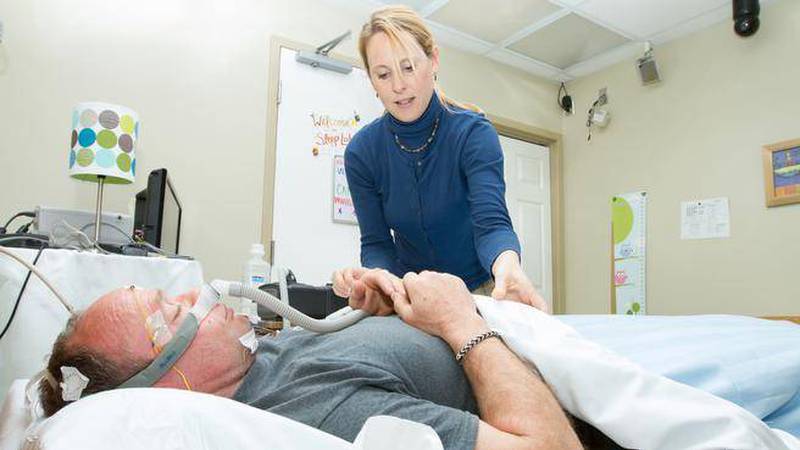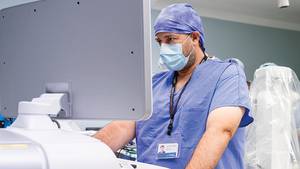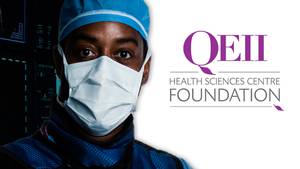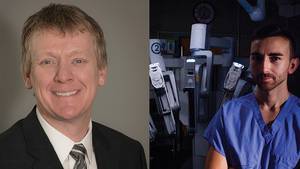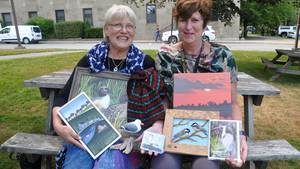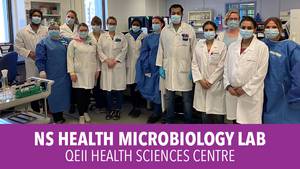 |
| For patients suffering from sleep apnea, the solution is often to be fitted with a continuous positive airway pressure (CPAP) device that assists in getting enough air. (Krista Hill photography) |
Jeff Mullen didn’t know what was wrong when he walked into his doctor’s office last October. He just felt very tired.
“I couldn’t stay awake,” he recalls. “I didn’t even feel I was safe to drive a car.”
It was worse than he thought. Tests revealed that Mullen was suffering from severe sleep apnea.
While he slept, his body was getting much less oxygen than it needed because he stopped breathing frequently during his sleep and when he did breathe, the breaths were too shallow — a critical situation that was putting a huge strain on his heart and creating a major risk of heart attack. Mullen had been a snorer for most of his life. The snoring had ominously stopped about two years before. “I wasn’t even getting enough oxygen to snore anymore,” he says. “By the time I got to my doctor my lips were blue, I was so oxygen-deprived.”
Mullen’s doctor referred him to the QEII Sleep Disorders Clinic. It was 9 a.m. on a Monday morning when they prepped him for sleep, led him into a darkened room and carefully fitted a Bilevel Positive Airway Pressure (BPAP) mask — a breathing assist device — on his face. Finally able to breathe, he drifted into a deep sleep. He woke up seven hours later. “I had the best sleep that I’d had in years. I really needed it.”
“We don’t always get those eureka moments,” says Carrie Edwards-Young, a polysomnographic technologist with the Sleep Disorders Clinic. “Usually it’s a process. But with a few patients you can see the light returning to their eyes very quickly. We’ve given them something very basic — a good night’s sleep.”
Mullen may be an extreme example, but thousands of Nova Scotians suffer from a wide range of disorders that keep them from getting the sleep they need. Sleep apnea is one of the more widely recognized disorders. Other problems include insomnia, restless legs syndrome and narcolepsy —a neurological disorder that affects control of the sleep wake cycle, with the patients suffering from excessive daytime sleepiness and cataplexy.
The QEII's Sleep Disorders Clinic has about 3,000 patient visits a year, with around 700 patients spending at least one night sleeping in one of the clinic’s laboratories while being carefully monitored by a polysomnographic technologist.
Dr. Debra Morrison is a respirologist and the clinical director of the Sleep Disorders Clinic. She says there is a tendency in our society not to take sleep problems seriously. The inability to cope with a lack of sleep is often seen as a weakness, not a health problem. That’s a mistake.
“Being sleep deprived is a real health risk,” she says. “You increase your risk of having an accident, you can suffer from depression, and your risk of developing cardiovascular disease, high blood pressure and other diseases is increased significantly.”
Morrison says that many patients arrive at the clinic with a sense that there isn’t much that can be done for their sleep issues. They are often surprised by the improvements that happen in just one or two visits. For patients suffering from sleep apnea, the solution is often to be fitted with a continuous positive airway pressure (CPAP) device that assists in getting enough air. The CPAP, and its more sophisticated version the BPAP, come with a mask that the sleeper wears during the night.
Some therapies are more low-tech. Patients who have trouble breathing on their backs may be fitted with a special tee shirt with a ball-type apparatus on the back that makes it uncomfortable to sleep in that position and helps to adjust to sleeping on their side. Lifestyle changes like diet, lower alcohol consumption and exercise can also help. For insomniacs, introducing a few lifestyle changes often helps to improve sleep.
The results can be dramatic.
“When many of our patients come to us, they are having trouble holding down jobs, driving, even maintaining relationships,” says Morrison. “After their treatments, they look physically different. They aren’t dragging themselves around. They’ve been transformed.”

